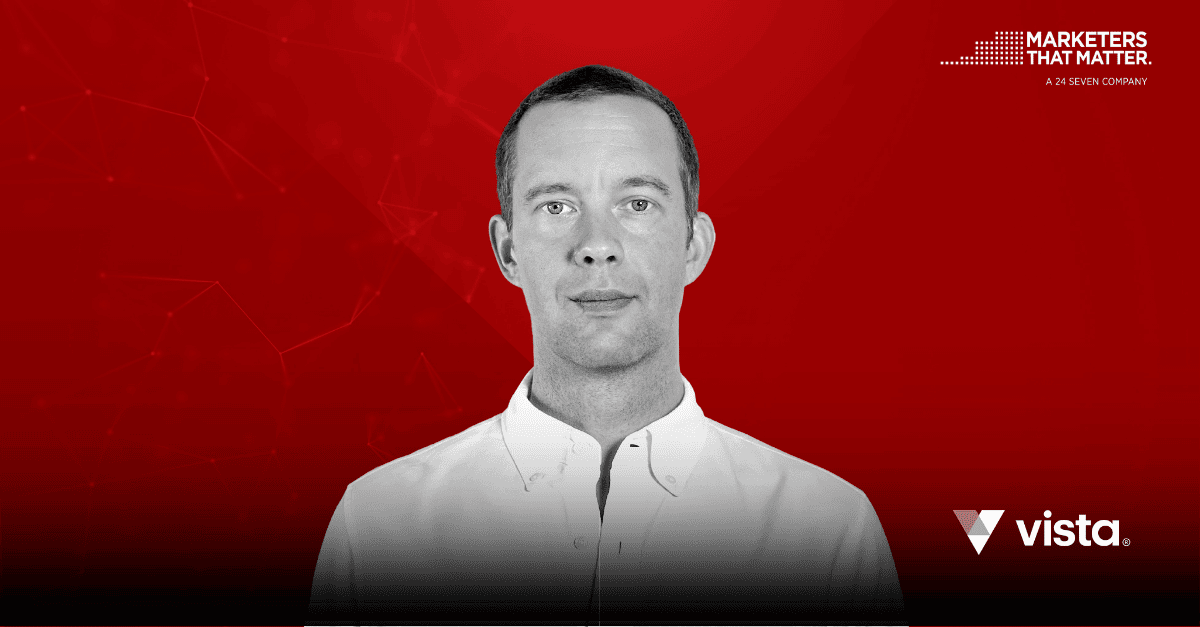Julian Cheevers is head of brand strategy at VistaPrint. He talks to us about how he is working with his team to develop a new story to capture how the company has expanded from being a print specialist to a design & marketing partner for small businesses.
Talk to us about how VistaPrint is expanding. Where are you at in that journey?
For 20 years VistaPrint has been a print specialist. In 2019 we created a new vision and trajectory to be a partner in design and marketing for small businesses.
Since then, we’ve acquired two design companies, VistaCreate, which is a DIY design tool, and 99designs, which enables you to collaborate directly with a designer. And we’ve expanded our print offering, which has really broadened our product range.
Now we’re embarking on repositioning. We’ve done our brand strategy, and we’re in the process of developing the work to tell our story. We’ve evolved our parent brand name from VistaPrint to Vista to help define ourselves beyond print. It’s now time to establish what we now also do across social, digital, and design and wrap that all up into a singular point of view.
For us, this is about helping small business owners elevate across all marketing touchpoints.
How are you working to shift brand perception to highlight how you’re expanding?
The first question for us when thinking through how we change perception through brand strategy is, “What is our current perception and why do people think of us this way?”
And then, “Where do we want to get to?”
We are working to make a big shift in our repositioning. So, something we really have to ask ourselves is, “Where do we have permission to change the perception” because if it’s not on strong ground, it’s going to be odd.
There are two areas that we integrated as part of brand strategy. One is our new products; they’re going to enable us to tell a new brand story. And the other is to look to our company truth, from our heritage to today, to our future, so we can identify that DNA.
For us, it’s that idea of personal touch. When we first came out, we pioneered custom design. Today we’ve got a really great customer care operation, which drives loyalty. So that DNA red thread, that personal touch, is one of the key pillars throughout our brand strategy.
And all of this gives us confidence that even though we are looking to shift perception, we’re doing it on strong strategic grounds.
How do you measure success with your brand initiative? What key metrics are you relying on?
We have a robust brand tracking approach that we look at quarterly, and we also look at campaign tracking. In addition to that, we have an annual brand equity study. So, we’re pretty dialed in on the attributes we want to move to create a distinct and powerful brand.
Of course, we also look at funnel behavior, engagement metrics, customer acquisition, and retention metrics.
In addition, we look at connecting with small business owners on the ground. We put a lot of value in learning about the impact we’re making, so through our ambassador program, we get a chance to connect with small businesses. And we use this as an opportunity to listen and learn. What do they need? What positive impact are we making – or could we make? This is valuable qualitative input that also influences how we direct our brand, along with the quantitative data.
Explain how you make these internal decisions? What are some of the trade-offs?
When it comes to brand, we’re thinking about long-term perception and how change is going to drive profitability. And if we say performance is a proxy for short-term business, how do we balance the long and short term? These are the conversations we have. We test our way to work out the right balance for our category, and business.
We need to invest in brand building in order to gain awareness around new capabilities and open the funnel to drive customer acquisition.
We also need to manage expectations about how long it takes to change perception and what attributes we want to change.
From a leadership point of view, we look to take people, not just in marketing, on the journey with us from insights to strategy. That way everyone feels invested and has had a chance to contribute to the process. So, when we get to the brand activation, or upper and middle funnel marketing, people understand what we’re doing, what success looks like, and feel co-ownership of the brand.
Marketers That Matter® is a community of top marketing executives coming together to pioneer the future of marketing, sharing real-time experiences, and solving current challenges.
Our parent company, 24 Seven, specializes in helping you find exceptional marketing and creative talent for your teams.


